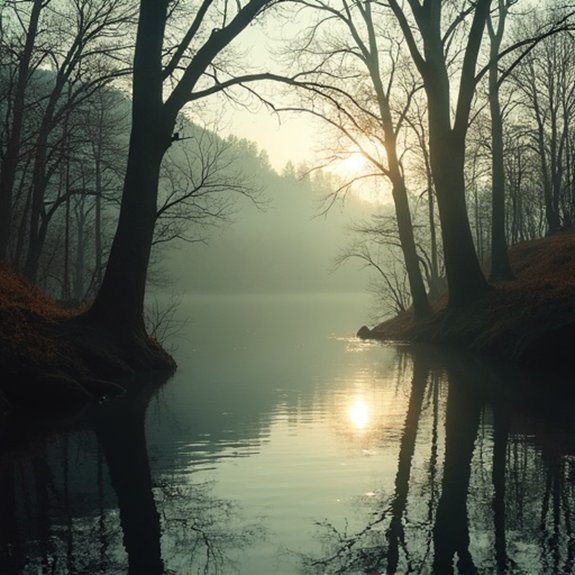The Flood Myth: Variations Worldwide
Ancient civilizations from Mesopotamia to the Americas independently recorded catastrophic flood stories that decimated humanity. These tales weren’t mere folklore—they’ve shaped religions, influenced moral codes, and sparked centuries of archaeological investigations. What’s driven scholars to uncover cuneiform tablets buried for millennia and compare indigenous oral traditions across continents? The answer lies in humanity’s most persistent mystery: why nearly every culture remembers a great deluge that supposedly never happened.
Introduction

The great flood narrative stands as one of humanity’s most enduring and widespread stories, appearing in the oral traditions and sacred texts of cultures that have never interacted with one another. From Mesopotamia’s Epic of Gilgamesh to Hindu puranas, from Aboriginal Australian dreamtime stories to Aztec codices, flood myths’ve emerged independently across six continents. These narratives typically share core elements: divine displeasure with humanity, a chosen survivor who’s warned in advance, the construction of a vessel, and the world’s subsequent renewal.
Scholars’ve proposed various theories to explain this phenomenon. Some suggest collective memories of actual prehistoric floods, while others point to psychological archetypes or cultural diffusion. Whatever their origin, these stories’ve shaped religious thought, moral teachings, and cultural identity for thousands of years.
Mesopotamian Cuneiform Tablets Discovered
When British archaeologists excavated the ancient library of Ashurbanipal in Nineveh during the 1850s, they’d uncovered thousands of clay tablets that would revolutionize understanding of ancient flood narratives. Among these fragments, George Smith identified the Epic of Gilgamesh in 1872, containing a flood story predating biblical accounts by centuries.
The tablets revealed Utnapishtim’s tale—a survivor who’d built an ark after divine warning, saved animals and family, then released birds to find dry land. Earlier discoveries included the Sumerian flood story featuring Ziusudra and the Akkadian Atrahasis epic. These parallel narratives shared striking similarities: angry deities, a chosen survivor, vessel construction, and post-flood sacrifices. The cuneiform texts proved flood myths weren’t unique to Hebrew tradition but reflected widespread Mesopotamian oral histories, possibly originating from actual flooding events in the Tigris-Euphrates basin.
Notable Cases or Sightings

How did explorers and researchers document flood traditions across vastly different cultures? Nineteenth-century missionaries first recorded Native American flood stories while establishing contact with indigenous tribes. James Frazer’s thorough 1918 study cataloged over 200 flood narratives from every inhabited continent. He’d discovered striking parallels between geographically isolated peoples.
Anthropologist Alan Dundes later examined 300 flood myths, finding that 95% featured divine punishment themes. Dorothy Significant’s geological investigations in the 1970s linked specific flood stories to actual prehistoric events. She matched Black Sea traditions with evidence of catastrophic flooding 7,600 years ago.
Modern researchers’ve documented flood narratives among Australia’s Aboriginals, dating back 10,000 years through oral tradition. The Ojibwe people’s account mirrors geological evidence of Lake Agassiz’s drainage. These cases demonstrate how myths often preserve collective memories of real disasters.
Common Theories or Explanations
Several competing theories attempt to explain why flood myths appear across unconnected cultures worldwide. The most prominent scientific explanation suggests that catastrophic regional floods throughout history inspired these stories. As civilizations developed near rivers and coastlines, they’d inevitably experience devastating floods that survivors would mythologize over generations.
Another theory proposes that rising sea levels after the last Ice Age created widespread flooding that ancient peoples witnessed and recorded through oral traditions. Psychologists argue these myths reflect universal human anxieties about natural disasters and divine punishment.
Some scholars believe cultural diffusion spread a single flood story from Mesopotamia through trade routes and migrations. Others suggest flood myths serve similar social functions across cultures—explaining natural phenomena, reinforcing moral codes, and providing creation narratives that unite communities.
Frequently Asked Questions
How Do Indigenous Oral Traditions Preserve Flood Stories Across Generations?
Indigenous communities preserve flood stories through ritualized storytelling, songs, and ceremonies. Elders pass narratives to younger generations during sacred gatherings, embedding them in cultural practices. They’ll often link stories to specific landmarks and seasonal events.
What Psychological Factors Make Flood Myths Universally Appealing to Cultures?
Flood myths appeal to cultures because they’re processing collective trauma from actual disasters, offering moral frameworks for renewal, and satisfying humanity’s need to explain catastrophic change through divine intervention and survival narratives that validate existence.
Are There Any Cultures Without a Flood Myth Tradition?
Yes, several cultures lack flood myths, including many African Sahel communities, Arabian Peninsula nomads, and Arctic peoples. These societies often developed in regions where catastrophic flooding wasn’t historically significant, shaping different mythological traditions instead.
How Do Modern Religious Communities Interpret Conflicting Flood Narratives?
Modern religious communities typically interpret conflicting flood narratives through three approaches: they’ll claim their version’s historically accurate while others are corrupted memories, view all as metaphorical teachings, or embrace them as shared human experiences reflecting universal truths.
What Role Did Ancient Climate Events Play in Shaping Flood Myths?
Ancient climate events like glacial melting and regional flooding shaped flood myths considerably. Scholars’ve identified that post-Ice Age deluges and catastrophic river floods inspired storytellers who transformed these traumatic memories into cultural narratives worldwide.


